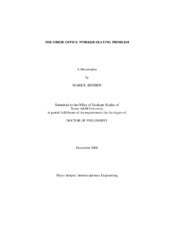| dc.description.abstract | A field study was performed using 51 participants that were randomly selected from
several Brazos Valley, Texas businesses to participate in an 8-hour assessment of office
seating habits that influence seating design and testing. A control group was established
as those with BMI’s < 35 and an obese group was established as those with BMI’s >35.
Data was collected through written survey and through data logging of seat and back
contact pressure (average and peak), surface area, center of gravity and duration of
contact by recording 8 metrics, once per second using the X-sensor pressure mapping
device and software. Additionally, 50 days of caster roll distance was recorded for the
participants using a caster mounted digital encoder. It was determined that at alpha =
0.05, using the Student’s T-test, a significant difference did exist between the groups in
mean seat time per shift (p<.001) back contacts per shift (p<.002), seat contacts per shift
(p<.01) and caster distance rolled per shift (p<.001). During a subsequent lab study, data
were collected during 3 cycles of ingress, egress on the armrest use, along with
anthropometry and critical chair testing parameters. Center of Gravity was measured
from a fixed backrest (front to rear) for 16 participants. 4 male and 4 female obese with
BMI greater than 35 and 4 male and 4 female with BMI less than 30 were compared.
The purpose of this study was to determine whether a significant difference existed
between anthropometric factors for normal and obese participants that would affect how a
chair should be loaded during testing. The null hypothesis that normal means and obese
means for each measure were equal was rejected by using independent samples T-test at
alpha = 0.05 with p<.001 significance reported for all measures. These data suggest a
need for a fresh look at several parameters used in the normal test standards as well as a
need for a tougher test method for seating designed for the obese worker. | en |


